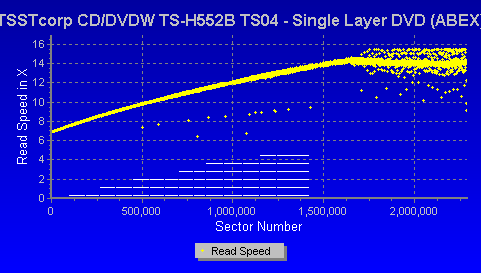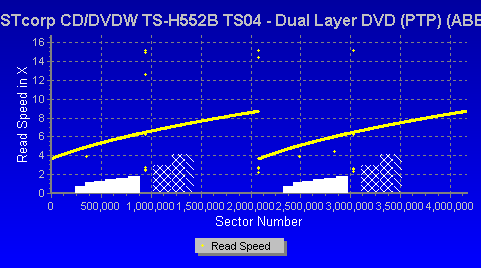Samsung TS-H552
4. DVD Error Correction Tests
Review Pages
2. Transfer Rate Reading Tests
3. CD Error Correction Tests
4. DVD Error Correction Tests
5. Protected Disc Tests
6. DAE Tests
7. Protected AudioCDs
8. CD Recording Tests
9. Writing Quality Tests - 3T Jitter Tests
10. Writing Quality Tests - C1 / C2 Error Measurements
11. DVD Recording Tests
12. CDSpeed/PlexTools Scans - Page 1
13. CDSpeed/PlexTools Scans - Page 2
14. CDSpeed/PlexTools Scans - Page 3
15. CDSpeed/PlexTools Scans - Page 4
16. CDSpeed/PlexTools Scans - Page 5
17. DVD+R DL - Page 1
18. DVD+R DL - Page 2
19. BookType Setting
20. Media Supported List
21. Conclusion
Samsung TS-H552 DL Recorder - Page 4
DVD Error Correction Tests
In the following tests we examine the DVD reading capabilities of the drive with scratched / defective DVD media. For the tests we used CDVD Benchmark and Nero CDSpeed. The reference test media came from ALMEDIO.
- Single Layer media
ABEX TDR-821
This is a single sided, single layer DVD-ROM with 4.7GB capacity, and its surface has an artificial scratch of dimensions varying from 0.4 to 3.0 mm.

The following transfer rate picture comes from the CDVD Benchmark v1.21 transfer rate test.

The drive read the contents of the 821 test disc without reporting any reading errors.
ABEX TDR-825
This is also a single sided, single layer DVD-ROM of 4.7GB capacity. The data structure of the disc is exactly the same as that of the TDR-821, with the difference that there are no scratches on it but instead defective areas of dimensions ranging from 0.5 to 1.1 mm.

There are also fingerprints sized between 65 and 75 micrometers.

Same steady performance, without any errors to report.
- Dual Layer media
ABEX TDR-841
This is an 8.5GB dual layer, single sided DVD-ROM disc with artificial scratches of dimensions ranging from 0.4 to 3.0mm, on both layers.
. 

The drive managed to read the defective area on the disc without any problems. There are also very few speed fluctuations (random yellow dots), indicating how effortlessly the drive read this disc.
ABEX TDR-825
ABEX TDR-845
The disc is a single sided, dual layer DVD-ROM disc with a capacity of 8.5GB. The only difference between the TDR-845 and the TDR-841 is that the first includes defective areas and fingerprints. The dimensions of the defective areas range from 0.5 to 1.1 mm and the fingerprints are sized from 65 to 75 micrometers.


The test finished successfully without reporting any errors. The results with all four discs is quite impressive and the drive appears to have no problems bypassing defects.
ABEX TDV-541
The TDV-541 is a single sided, dual layer DVD-VIDEO disc, with a capacity of 8.5GB.The disc is based upon the TDV-540 series which is designed for inspection and adjustment of DVD-VIDEO players. The disc checks the layer switch operation from layer 0 to layer 1 and also includes test pictures and test signals for DVD sound files.

The current TDV-541 also checks the error correcting capabilities of the drive and includes scratches from 0.4 to 3.0 mm.
The graph above indicates the excellent capabilities of the Samsung drive.
ABEX TDV-545
The TDV-545 disc is based on the TDV-540 series. It is a single sided, dual layer DVD-VIDEO disc with a capacity of 8.5GB.

The TDV-545 includes artificial black dots on the disc's surface, sized from 0.4 to 1.0 mm. It also has 65 - 75 micrometer thickness, fingerprints.
Black dots and fingerprints on the disc's surface did not create any reading problems, and the drive finished the task successfully.
Review Pages
2. Transfer Rate Reading Tests
3. CD Error Correction Tests
4. DVD Error Correction Tests
5. Protected Disc Tests
6. DAE Tests
7. Protected AudioCDs
8. CD Recording Tests
9. Writing Quality Tests - 3T Jitter Tests
10. Writing Quality Tests - C1 / C2 Error Measurements
11. DVD Recording Tests
12. CDSpeed/PlexTools Scans - Page 1
13. CDSpeed/PlexTools Scans - Page 2
14. CDSpeed/PlexTools Scans - Page 3
15. CDSpeed/PlexTools Scans - Page 4
16. CDSpeed/PlexTools Scans - Page 5
17. DVD+R DL - Page 1
18. DVD+R DL - Page 2
19. BookType Setting
20. Media Supported List
21. Conclusion























